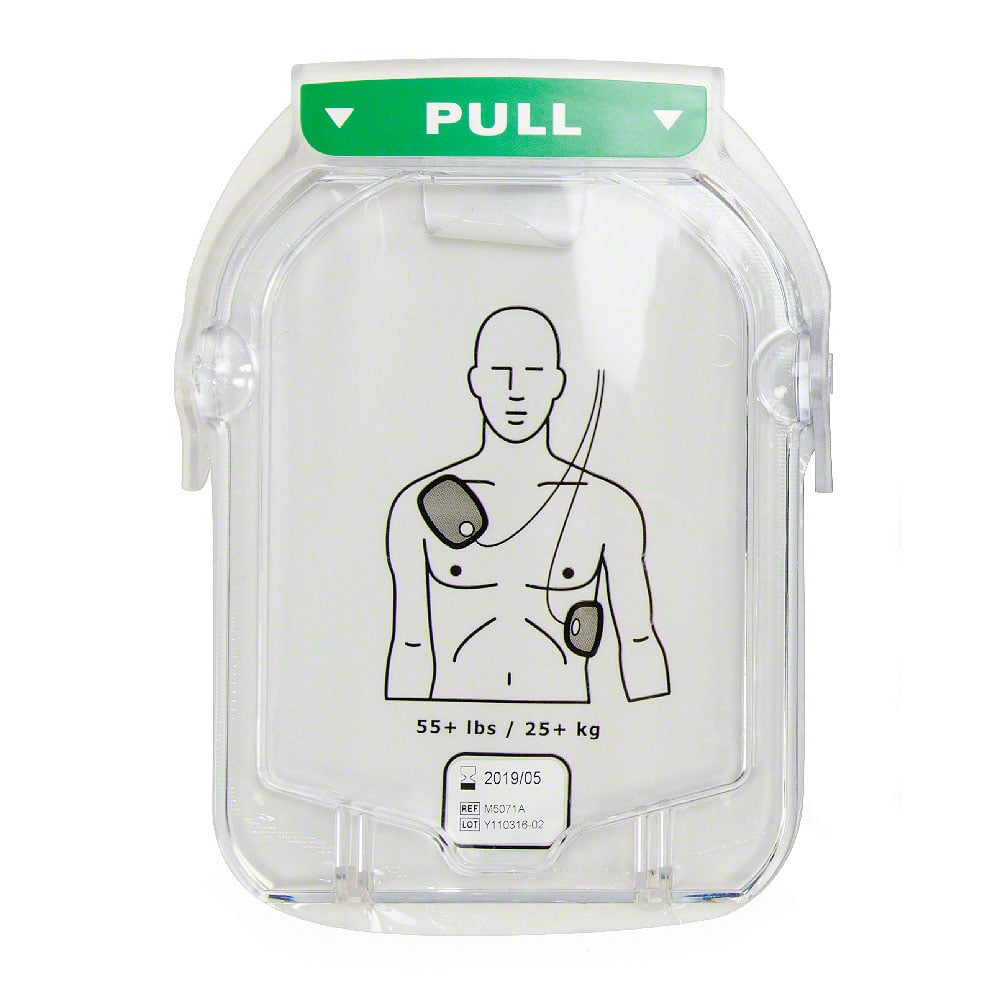Choosing your first automated external defibrillator (AED) can feel like a heavy decision. You're investing in a tool that can save a life. When you start comparing top models like the HeartSine Samaritan and the Philips HeartStart OnSite, the technical specs can be overwhelming. This guide cuts through the noise. We're not just going to list features. We’re going to walk through the practical differences that matter most to a home, school, or small business owner, so you can make a confident choice for your community.
Every minute that passes during a sudden cardiac arrest event, the chance of survival drops by about 10 percent. An accessible AED can literally be the difference between life and death. Let's make sure you have the right one.
The ultimate showdown HeartSine 350P vs Philips OnSite

At a glance, both the HeartSine Samaritan PAD 350P and the Philips HeartStart OnSite are excellent, FDA-approved devices designed for use by the general public. They both guide rescuers with clear voice prompts and are trusted by organizations worldwide. However, they are built on different philosophies of design, maintenance, and durability. Understanding these differences is the key to choosing the best fit for your environment.
The three key battles where the right choice is made
To move beyond a simple feature list, we need to compare these AEDs on the three factors that truly impact a first-time buyer, ease of use in a crisis, long-term cost of ownership, and how well the device holds up over time with minimal fuss.
Ease of use for someone who is panicking
In a real emergency, simplicity is everything. Both devices are designed to be used by someone with no medical background, but they approach it differently.
The Philips HeartStart OnSite features loud, clear voice instructions that walk you through every step, from pad placement to CPR. It even has a feature that allows you to press a blue "i" button for extra CPR coaching.
The HeartSine Samaritan 350P also provides clear voice and visual prompts. Its design is incredibly straightforward with just two buttons, On/Off and Shock. It uses a flashing green light to signal it's ready, which is a simple but effective visual cue. Many users find its compact and lightweight design less intimidating, making it easier to grab and go without hesitation. Ultimately, both are exceptionally user-friendly, but your preference might come down to whether you want the most streamlined interface (HeartSine) or the option for more detailed CPR guidance (Philips).
Long-term cost the hidden expense
The initial purchase price is just one part of the equation. The real cost of owning an AED is revealed over its lifespan through its consumables: the electrode pads and batteries. This is where the HeartSine and Philips models differ most significantly.
The Philips OnSite requires you to track and purchase two separate items, a battery with a four-year life and electrode pads with a two-year life. Over ten years, you're looking at replacing the battery once and the pads four or five times.
The HeartSine Samaritan has a revolutionary approach with its single-unit Pad-Pak. This cartridge combines the battery and electrode pads into one piece with a single, four-year expiration date. When it expires, you replace the entire unit. This system simplifies maintenance and often results in a lower total cost of ownership over the device's life. You only have one date to track and one item to replace, which is a major advantage for busy facility managers or homeowners.
Durability and maintenance the set it and forget it test
An AED needs to be ready the moment it's needed, which means it must withstand the conditions of its environment and perform regular self-tests.
The Philips OnSite has an Ingress Protection (IP) rating of IP21. This means it is protected from condensation and dripping water, making it suitable for most indoor office or home environments.
The HeartSine Samaritan, however, boasts an impressive IP56 rating. This is one of the highest ratings in the industry, signifying it is highly resistant to dust and can withstand powerful jets of water. This superior durability makes it the clear choice for more demanding environments like workshops, pools, gyms, boats, or any setting where dust and moisture are a concern. Furthermore, the HeartSine performs a weekly self-test, giving you constant assurance that the device is ready.
The verdict which AED should you buy

The right choice depends entirely on your priorities and where the AED will live. Both devices will save a life, but one is likely a better fit for your specific situation.
You should choose the HeartSine Samaritan 350P if:
-
Low long-term cost is a priority:
The combined Pad-Pak system is typically more affordable over the life of the device. -
The AED will be in a demanding environment:
The superior IP56 rating offers peace of mind in places with dust or moisture. -
You want the simplest possible maintenance:
One expiration date is easier to manage than two. -
A compact, lightweight device is important:
It's one of the smallest and lightest AEDs available, making it highly portable.
You should choose the Philips HeartStart OnSite if:
-
Brand familiarity is important to you:
Philips is a globally recognized household name. -
You want enhanced CPR coaching:
The optional "i" button provides more detailed instructions for rescuers. -
The AED will be in a standard, climate-controlled indoor location:
The IP21 rating is sufficient for most office or home settings.
For most first-time buyers creating a public access defibrillation program, the HeartSine Samaritan 350P often emerges as the more practical choice due to its robustness, lower lifetime cost, and simplified maintenance schedule.
Building a complete safety solution
Your AED is the cornerstone of your emergency preparedness plan, but it works best as part of a system. To maximize readiness, consider a proper wall cabinet for visibility and protection, clear signage, and a first responder kit.
Most importantly, an AED is most effective when bystanders are trained and confident. Combining your device with accessible CPR and AED training empowers your family, staff, or community members to act decisively. Managing multiple devices can also be simplified with tools like the Response Ready App, which automates readiness checks and compliance reminders.
Frequently asked questions
Q: Do I need a prescription to buy either of these AEDs?
A: No. While AEDs are regulated by the FDA, the Philips OnSite is available for purchase without a prescription. Response Ready provides the necessary medical oversight and prescription for any AED that requires one, like the HeartSine models, as part of your purchase, ensuring you are fully compliant.
Q: What is the difference between a semi-automatic and fully automatic AED?
A: A semi-automatic AED (like the HeartSine 350P and Philips OnSite) will prompt the rescuer to push a shock button if a shock is advised. A fully automatic model (like the HeartSine 360P) will provide a verbal warning and deliver the shock automatically without requiring you to press a button. Both are safe and effective, and the choice often comes down to organizational preference.
Q: Can I hurt someone by using an AED?
A: No. An AED is designed to be foolproof. It will analyze the patient's heart rhythm and will only advise and deliver a shock if it detects a life-threatening arrhythmia. It will not shock a person with a normal heart rhythm. The greatest danger is hesitating to use one.
Q: What happens if I forget to replace the battery or pads?
A: This is a major risk, as the device may fail to work in an emergency. This is a key reason many prefer the HeartSine Pad-Pak system, as it simplifies maintenance to a single component with one date. Both devices perform regular self-tests and will emit a chirping sound or visual alert to let you know a consumable needs attention. Using an AED program management service, like the Response Ready App, can automate these reminders for you.






